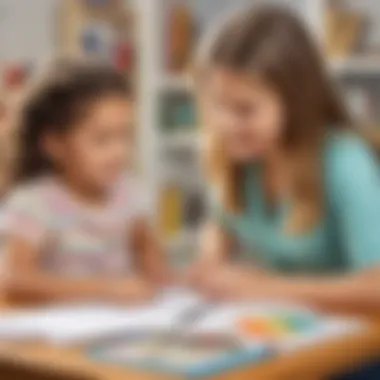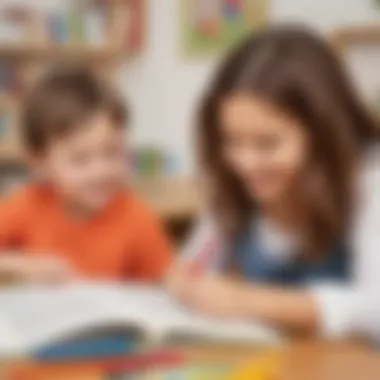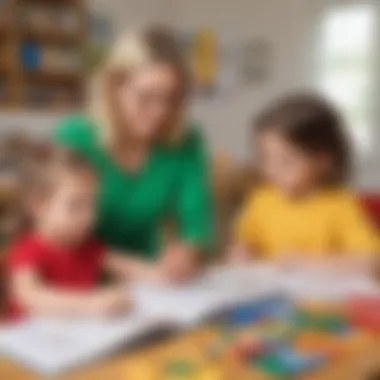Choosing the Ideal Homeschool Curriculum for Preschoolers: A Comprehensive Guide


Fun Activities Ideas
When it comes to homeschooling preschoolers, incorporating fun activities is not just beneficial but crucial. Engaging children in indoor activities helps stimulate their creativity and problem-solving skills. Simple activities like building blocks or sorting games can enhance their cognitive development. Moving on to outdoor adventures, nature walks and scavenger hunts can instill a love for the environment and encourage physical activity. Arts and crafts offer a fantastic outlet for self-expression, allowing children to explore different textures and colors. Science experiments spark curiosity and a love for learning, with simple experiments like making a volcano or planting seeds captivating young minds. Cooking and baking activities not only teach practical life skills but also foster a sense of independence and accomplishment.
Educational Games
Integrating educational games into the homeschool curriculum can make learning fun and engaging for preschoolers. Math and logic games help develop critical thinking and problem-solving abilities. Language and vocabulary games enhance literacy skills and expand children's communication abilities. STEM activities, focusing on science, technology, engineering, and mathematics, introduce young learners to the wonders of these fields through hands-on experiments and projects. History and geography puzzles create an opportunity for children to explore the world around them and develop an understanding of different cultures. Interactive learning apps provide a modern twist to traditional learning methods, making education interactive and personalized.
Seasonal and Holiday Activities
Seasonal and holiday activities add a festive touch to the homeschool curriculum, making learning more enjoyable and relevant. Valentine's Day crafts ignite creativity and promote expression of love and appreciation. Halloween costume ideas encourage imaginative play and exploration of different characters. Thanksgiving cooking projects teach children about gratitude and the importance of giving back through shared meals. Christmas decorations bring joy and an element of tradition to the learning environment, celebrating the spirit of the season. New Year's resolutions for kids promote reflection and personal growth, instilling valuable habits and goal-setting skills.
Parenting Tips and Resources
Equipping parents with valuable tips and resources is essential for a successful homeschooling journey. Encouraging creativity in children nurtures innovation and fosters a love for learning. Setting up a playful learning environment creates a conducive space for exploration and discovery. Balancing screen time and playtime is crucial in maintaining a healthy lifestyle and promoting holistic development. Building strong family bonds through shared activities and open communication lays a solid foundation for growth and learning. Motivating kids to stay active through physical exercise and outdoor play supports overall well-being and active learning.
Fun Facts and Trivia
Exposing preschoolers to fun facts and trivia adds an element of excitement and curiosity to their learning experience. Discovering the wonders of the animal kingdom through interesting facts about different species sparks a sense of wonder and appreciation for nature. Exploring famous inventions stories inspires creativity and showcases the power of innovation throughout history. Delving into historical events tailored for kids makes learning about the past engaging and relatable. Uncovering mythical creatures stories stirs imagination and introduces children to folklore and storytelling traditions. Embarking on space adventures and discoveries ignites a fascination for the cosmos and encourages a passion for exploration and discovery.
Understanding Preschool Learning Needs
Understanding the educational requirements of preschool-aged children is a pivotal aspect in the realm of homeschooling curriculum selection. The cognitive and socio-emotional development during the early years play a crucial role in shaping a child's future abilities and behaviors. Parents and educators need to delve into the specifics, considering factors like cognitive development and socialization skills. By assessing these needs accurately, a tailored approach to learning can be designed to maximize the child's potential and prepare them for future academic challenges.
Cognitive Development
In the realm of cognitive development, engaging activities serve as fundamental tools to stimulate young minds. These activities, ranging from basic puzzles to interactive storytelling, aim to enhance problem-solving skills and increase attention span. Their hands-on nature encourages children to explore and experiment, fostering a deep understanding of concepts through experiential learning. While some mediums like electronic devices might offer instant gratification, hands-on activities promote a more profound comprehension of the subject matter. By honing critical thinking skills through such tasks, children can cultivate a mindset capable of analyzing situations, evaluating information, and making informed decisions.
Social and Emotional Growth


The social and emotional growth of preschoolers is equally significant in their overall development. Interactive learning environments create spaces where children can engage with peers, share ideas, and develop crucial social skills. This interactive approach helps in building communication, collaboration, and empathy among children. On the other hand, focusing on emotional intelligence enables children to understand and regulate their emotions effectively. Activities that promote emotional intelligence aid in developing self-awareness, emotional management, and relationship-building skills, all of which are essential for a child's holistic growth and well-being.
Exploring Different Teaching Approaches
Exploring Different Teaching Approaches is a pivotal aspect of selecting the most conducive homeschool curriculum for preschoolers. It plays a significant role in shaping the learning journey of young minds by offering diverse methodologies to cater to their individual needs and preferences. By delving into various teaching approaches, parents and educators can gain valuable insights into the most effective ways to engage and educate preschool-aged children. This section will elucidate the importance of considering different teaching approaches, highlighting the benefits and essential factors to ponder upon when making this crucial decision.
Montessori Method
Hands-On Learning
Hands-On Learning is a fundamental component of the Montessori Method, emphasizing interactive and experiential education. This pedagogical approach prioritizes tactile experiences, enabling children to learn through direct manipulation of materials and objects. Its hands-on nature fosters a deeper understanding of concepts, enhances problem-solving skills, and promotes creativity. The unique feature of Hands-On Learning lies in its ability to actively engage young learners, facilitating a holistic learning experience. While it encourages exploration and experimentation, some challenges may arise in ensuring structured progression within this dynamic learning environment.
Independence
Independence is a core value within the Montessori educational philosophy, empowering children to take ownership of their learning journey. By fostering a sense of independence, preschoolers develop self-discipline, decision-making skills, and a strong sense of responsibility. This aspect emphasizes the importance of self-directed learning and encourages children to explore their interests at their own pace. The autonomy provided by the Montessori approach nurtures confidence and autonomy in young learners, preparing them for future academic pursuits. However, maintaining a balance between freedom and guidance is crucial to optimize the benefits of this philosophy.
Reggio Emilia Approach
Artistic Expression
Artistic Expression is a cornerstone of the Reggio Emilia Approach, valuing creativity and self-expression in early childhood education. This aspect celebrates the innate artistic abilities of children, facilitating the use of various art forms as tools for communication and exploration. By incorporating art into the learning process, preschoolers can develop cognitive and sensory skills while expressing their thoughts and emotions visually. The unique feature of Artistic Expression lies in its ability to nurture imagination, aesthetic appreciation, and cultural awareness. Despite its numerous advantages, integrating artistic experiences into the curriculum may require careful planning and resources to ensure a balanced educational experience.
Community Involvement
Community Involvement is a key component of the Reggio Emilia Approach, emphasizing collaboration, social interaction, and civic engagement. This aspect underscores the significance of community relationships in the learning process, providing children with opportunities to connect with others and contribute to their social environment. By involving the community in educational activities, preschoolers develop a sense of belonging, cultural appreciation, and empathy. The unique feature of Community Involvement lies in its ability to broaden children's perspectives, promote inclusivity, and foster shared responsibility. However, effectively incorporating community elements into the curriculum requires coordination and support from various stakeholders.
Traditional Curriculum
Structured Learning


Structured Learning is a fundamental characteristic of traditional curriculum models, emphasizing a systematic and organized approach to education. This aspect focuses on clear learning objectives, sequential progression of topics, and formal assessments to measure student performance. The key characteristic of Structured Learning lies in its ability to provide a consistent framework for teaching and learning, ensuring that essential concepts are covered in a logical sequence. By offering a structured environment, preschoolers benefit from clear expectations, academic rigor, and targeted skill development. However, the rigidity of structured learning approaches may limit individual creativity and adaptability, posing challenges in accommodating diverse learning styles.
Academic Focus
Academic Focus is a central tenet of traditional curriculum designs, prioritizing the acquisition of core academic competencies such as literacy, numeracy, and science. This aspect places emphasis on cognitive development, content mastery, and standardized assessments to evaluate student progress. The unique feature of Academic Focus lies in its commitment to preparing children for academic success, equipping them with essential knowledge and skills for future educational endeavors. While academic focus instills discipline and intellectual growth, it may inadvertently neglect other aspects of early childhood development such as creativity, emotional intelligence, and social skills. Striking a balance between academic rigour and holistic development is essential to maximize the efficacy of traditional curriculum structures.
Factors to Consider When Choosing a Curriculum
Selecting the appropriate curriculum for preschoolers is a critical decision that can significantly impact their educational journey. Understanding the diverse learning styles and preferences of young children is paramount in creating a conducive learning environment. When considering a curriculum, various factors come into play, such as the child's cognitive abilities, social development, and emotional needs. It is essential to evaluate the curriculum's alignment with the child's interests and learning pace to foster a positive and engaging learning experience. Additionally, assessing the flexibility and adaptability of the curriculum is crucial to ensure it can be tailored to meet the individual needs of each child. By choosing a curriculum that addresses these factors comprehensively, parents and educators can create a dynamic and enriching learning environment for preschoolers.
Learning Styles
Visual, Auditory, Kinesthetic
Understanding the different learning styles, namely visual, auditory, and kinesthetic, plays a pivotal role in designing a curriculum that caters to the diverse needs of preschoolers. Visual learners thrive in environments where information is presented through images, charts, and diagrams. Auditory learners, on the other hand, excel when information is delivered through spoken words, discussions, and auditory cues. Kinesthetic learners learn best through hands-on activities, movement, and tactile experiences.
Each learning style has its unique characteristics and benefits. Visual learners tend to have a strong visual memory, making visual aids and graphics invaluable in their learning process. Auditory learners grasp information effectively through listening and verbal instruction, enhancing their comprehension and retention. Kinesthetic learners benefit from active engagement and physical involvement, leading to better understanding and retention of concepts.
While each learning style offers distinct advantages, it is essential to note that children often exhibit a combination of these styles to varying degrees. A well-rounded curriculum should incorporate elements that cater to all three learning styles, ensuring that every child has the opportunity to learn in a way that aligns with their strengths and preferences.
Flexibility and Adaptability
Customization Options
Customization options within a curriculum empower parents and educators to tailor the learning experience to suit the unique needs of each child. By offering customizable features, such as flexible scheduling, personalized assignments, and adaptive assessments, a curriculum can be optimized to cater to individual learning styles and pace.
Customization options also allow for the integration of supplementary materials and resources based on a child's interests and areas of improvement. This tailored approach fosters a sense of ownership and engagement in the learning process, motivating children to explore and discover knowledge at their own pace.
Progress Tracking


Incorporating progress tracking mechanisms in a curriculum enables parents and educators to monitor a child's academic development and identify areas that may require additional support or enrichment. By tracking a child's progress, it becomes easier to assess learning outcomes, adjust teaching strategies, and celebrate achievements.
Progress tracking also provides valuable insights into a child's strengths and weaknesses, helping in the formulation of targeted interventions and personalized learning plans. By utilizing progress tracking effectively, parents and educators can ensure that a child's educational journey is both fulfilling and productive.
Reviews of Top Preschool Homeschool Curricula
In this segment, we delve into the critical aspect of evaluating preschool homeschool curricula. Understanding the essence of comprehensive reviews aids parents and educators in making well-informed decisions to meet the unique requirements of preschoolers. By assessing top curricula, individuals can pinpoint the most suitable educational approach tailored to cater to the learning needs of young children. These reviews not only highlight the strengths of each curriculum but also shed light on any potential drawbacks, offering a holistic view to aid in decision-making.
ABC Mouse
Interactive Learning Games
An essential component of the ABC Mouse curriculum is its interactive learning games. These tailored games facilitate engaging learning experiences for preschoolers. The incorporation of interactive elements enhances overall interest and involvement in educational activities, promoting effective retention of concepts. The interactive nature of these games fosters a more immersive learning environment, encouraging children to actively participate in their education. However, challenges may arise in some situations, possibly leading to minor disruptions in the learning flow.
Multisensory Approach
The ABC Mouse curriculum embraces a multisensory approach to learning, stimulating various senses concurrently. This approach not only caters to visual and auditory learners but also benefits kinesthetic learners by providing diverse avenues for comprehension and skill development. Capitalizing on multiple senses enhances memory retention and concept understanding, making learning more accessible and impactful for young learners. Nonetheless, occasional errors could occur, potentially affecting the seamless integration of multisensory activities.
Hooked on Phonics
Phonics-Based Learning
A fundamental aspect of the Hooked on Phonics curriculum is its emphasis on phonics-based learning. This approach focuses on teaching children to decode words by understanding the relationship between sounds and letters. Phonics-based learning serves as a foundational skill for reading and writing, empowering preschoolers with the ability to decipher words independently. The systematic nature of phonics instruction promotes strong literacy skills, laying a robust groundwork for future academic success. However, occasional issues can disrupt the learning process, necessitating additional attention to maintain continuity.
Reading Comprehension
Another critical facet of the Hooked on Phonics curriculum is its dedicated focus on reading comprehension. Beyond decoding words, this aspect emphasizes understanding and interpreting written material. By honing reading comprehension skills, preschoolers develop the ability to extract meaning from texts effectively, enhancing overall literacy proficiency. Improved reading comprehension not only fosters a love for reading but also cultivates critical thinking and analytical skills in young learners. Yet, occurrences may inadvertently impede seamless comprehension exercises, requiring careful monitoring and adjustment.
Blossom and Root
Nature-Based Curriculum
Blossom and Root stands out for its nature-based curriculum, offering a unique educational experience centered around the natural world. This unconventional approach integrates outdoor exploration, nature studies, and environmental awareness into the learning journey. Through a nature-based curriculum, preschoolers engage with the environment, fostering a deeper connection with the world around them while promoting ecological consciousness. However, occasional hiccups might disrupt outdoor activities, necessitating flexibility and adaptability in implementing nature-based learning.
Creative Arts Focus
Central to the Blossom and Root curriculum is its creative arts focus, encouraging artistic expression and imaginative exploration. By incorporating various art forms and creative outlets, this curriculum nurtures creativity and aesthetic appreciation in preschoolers. Engaging in artistic activities fosters fine motor skills, self-expression, and emotional development, enriching the holistic growth of young learners. Nevertheless, occasional occurrences could impact the seamless flow of creative projects, warranting flexibility and troubleshooting to maintain the artistic focus.



